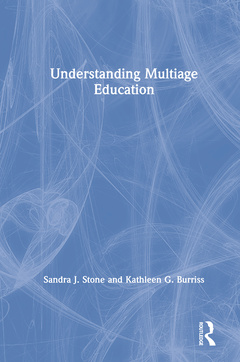Description
Understanding Multiage Education
Authors: Stone Sandra J., Burriss Kathleen G.
Language: English
Subject for Understanding Multiage Education:
Keywords
Multiage Classroom; Sandra J; Stone; Multi-age Classroom; Kathleen Burriss; Student’s GPA; multiage; Integrated Curriculum Model; multiage education; Authentic Assessment Tools; curriculum; Mixed Age Classroom; mulitage classroom; Lesson Plan Approach; combination class; Multiage Learning; mixed-age groupings; Multiage System; classroom space; Multiage Setting; classroom structure; Logico Mathematical Knowledge; Children’s Current Understanding; Mixed Age Group; Multiage Grouping; Grade Level Curriculum; Multiage Environment; Education System; Multiage Structure; Guided Math; Mixed Age Play; Grade Level Expectations; Authentic Assessment; Professional Development; DI
166.30 €
In Print (Delivery period: 14 days).
Add to cartPublication date: 05-2019
· 15.2x22.9 cm · Hardback
Approximative price 50.12 €
In Print (Delivery period: 14 days).
Add to cartPublication date: 05-2019
· 15.2x22.9 cm · Paperback
Description
/li>Contents
/li>Readership
/li>Biography
/li>
Presenting a compelling case for changing our system of education from a graded, curriculum-centered approach to a multiage, child-centered approach, Understanding Multiage Education is a comprehensive exploration of the philosophy and foundations of multiage education.
Veteran educators Stone and Burriss examine the "why" of multiage education, exploring how multiage classrooms' structure, environment, strategies, and assessments unfold and complement the multiage philosophy and pedagogy. Delineating the differences between a standard and a mixed-age approach, each chapter features Inside Insights, short vignettes, case studies, examples of multiage in practice and discussion questions challenging readers to engage with the core concepts and examine how we might define success in a multiage classroom.
Designed for graduate-level students of early childhood, elementary, and general education courses, as well as experienced practitioners, this is an essential guide for anyone interested in understanding the rationale, implementation, and benefits of multiage education.
1. System: Graded or Multiage Education? Inside Insights 1.1: The Pedagogy of Multiage Education 1.2: Montessori: A Different Path and Approach 2. Benefits: Why Multiage Education? Inside Insights 2.1: A Multiage Family: Diverse Community of Learners 2.2: Crisis in Creativity 3. Structure: Is It a Multiage or Combination Class? Inside Insight 3.1: Specialists in Multiage Schools: Experiences of Art Educators 4. Learning: Strategies Versus Lesson Plans? Inside Insight 4.1: Young Social Scientists 5. Learning: Goals Versus Objectives? Inside Insight 5.1: Multiage Inquiry Science Project in Finland 6. Role of the Teacher: Facilitator or Instructor? Inside Insight 6.1: Can We Build a Worm Center? 7. Curriculum: Are Mixed-age Groupings Too Diverse to Teach Effectively? Inside Insight 7.1: Middle School Multiage Projects 8. Assessment: What Is Appropriate? Inside Insight 8.1: Technology, Learning, and Community 9. Standards: Is There a Conflict? Inside Insight 9.1: Neoliberal Thinking, Teachers’ Instruction, and Children’s Learning 10. Self-Contained or Team Teaching? Which Classroom Structure Is Best for Children? Inside Insight 10.1: Bullying: Less Likely in a Multiage Setting 11. Mixed-age Grouping: Is It Really Important? Inside Insights 11.1: The Value of Mixed-age Play 11:2: Mixed-age Children Digging Holes Outside 12. Classroom Space: "Curriculum Tasks" or "Learning Environment?" Inside Insights 12.1: Designing Spaces for Children to Thrive 12.2: Let’s Go Outdoors: A Learning Opportunity 12.3: Bilingual Projects in a Primary Multiage Classroom in Japan 13. Defining Success: What Do We Really Want for Our Children? Inside Insight 13.1: Multiage Classrooms: Responsive and Inclusive Learning Communities 14. Change: Why Is It So Difficult? Inside Insight 14.1: The Long and Winding Road to Multiage Classrooms Inside Insight 14.2:The Folly of Homework: A Parent’s View 15. Change: What Are the Possibilities? Inside Insight 15.1: Beyond Measure 16. The Vision: The Future of Multiage Education
Sandra J. Stone is Professor Emeritus and founder of the National Multiage Institute at Northern Arizona University, USA.
Kathleen G. Burriss is Professor at Middle Tennessee State University, USA.




